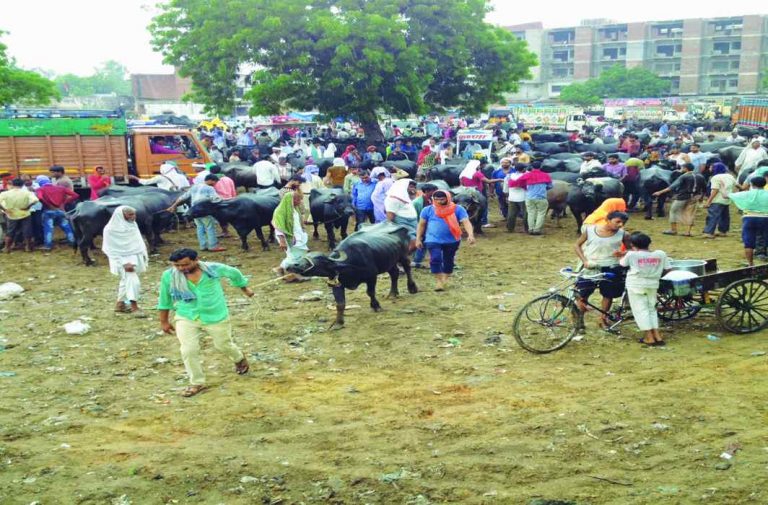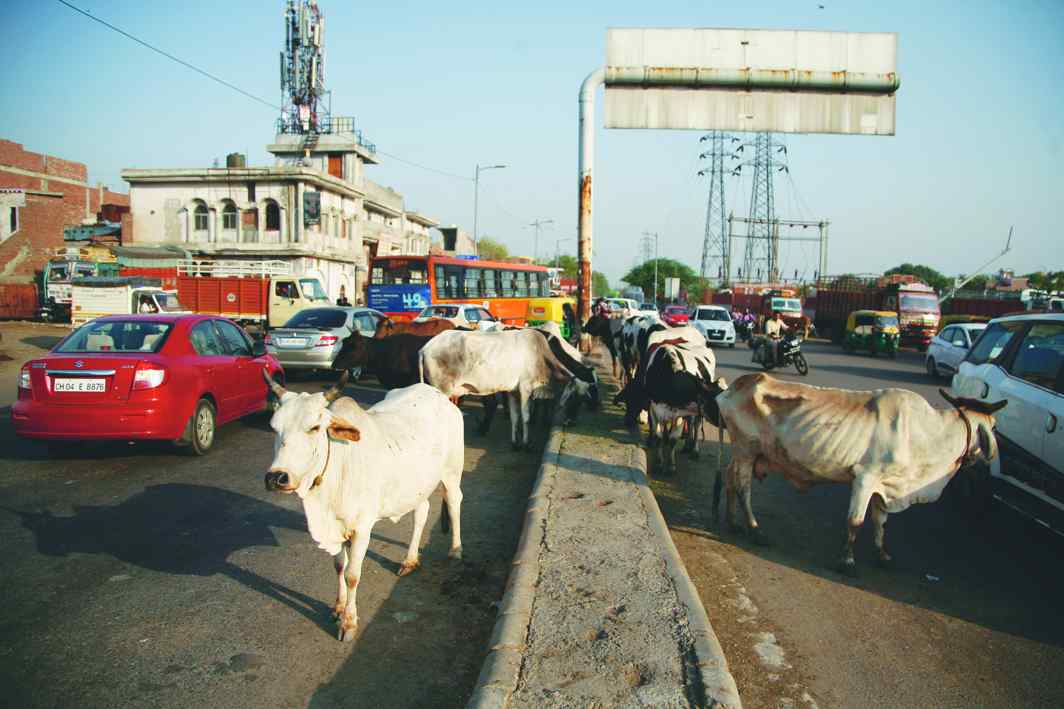
Above: The new regulations are needless for open cattle markets like the one in Laxmi Nagar in Mathura and create problems for the traders. Photo: Vivian Fernandes
A visit to an animal market shows that the centre’s strict rules regarding them are needless and has put to hardship many cattle traders
~By Vivian Fernandes in Mathura
A visit to the pashu penth at Laxmi Nagar in Mathura recently showed the absurdity of the new cattle market rules which were notified by the environment ministry on May 23. The Madras High Court had stayed the implementation of the regulations banning sale and purchase of cattle from markets for slaughter and the Supreme Court had extended the stay to the entire country. After an outcry from farmers and those engaged in the meat trade, the environment ministry has said it would tweak the regulations. But they should be largely junked.
The animal market which comes alive every Saturday is eight kilometres from the Yamuna Expressway, which connects Delhi and Agra. It is a 15,000 sq m expanse of dirt, dung and plastic litter. Everything seems to happen at the same time: the haggling, the hawking, the loading and unloading, the spitting and clearing of throats, the loud conversations, the heckling and calling, the exchange of cash, the writing of parchis or purchase slips, the eating of kachoris, parathas and rabri with scant regard to the filth and drizzle, the boiling of milky tea over little stoves, the sale of fruits, vegetables, a jooti seller requesting people not to block his customers….
LEGITIMATE SALES
It is a scene of frenetic activity that begins in summer at four in the morning. By noon, the market is just a memory to be revived the following Saturday. Here men (only men) share space with animals. It is an open field with a few trees for shade. Only buffaloes are traded here. They go to the slaughter houses in Aligarh and Unnao, said Sandeep Gupta, who belongs to the joint family which owns the site. Cows and cattle are not traded, he said, after a member of the family joined People for Ethical Treatment of Animals, a rights group. They charge Rs 100 per traded animal.
On the day this correspondent visited it, Gupta said about 200 trucks would have left the market. Each holds about nine to ten animals. Gupta is evasive about the exact number of animals traded, though he keeps tab through clerks who are licensed by the municipal corporation. They write purchase slips, which are proof that the animals were legitimately sold and not stolen. Between 1,600 and 2,000 animals may have been traded on the day of the visit.

There are herds of calves as well. These are sold in eastern Uttar Pradesh and the adjoining areas of Bihar, where they are reared till the lactating stage by grazers in open pastures or forest land. They are then sold to dairy farmers.
Gupta says the market was established in the 1930s. Faster transport and the network of roads connecting villages enable farmers to trade and return the same day. No one stays overnight. This is what makes the new, elaborate regulations so unnecessary. They prescribe standards that would be every farmer’s envy. The markets have to be covered. They should have non-slippery flooring. There must be a ramp for animals to climb up and down the vehicles. An enclosure must separate sick animals. There must be an on site area for disposal of dead animals and facilities for evacuation of dung and urine. The animals must be provided “wholesome food” and “wholesome water”. There should be running water and enough number of taps and troughs.
Every owner and buyer will have to give an undertaking that traded cattle will not be given for slaughter. The buyer has to file documents in quintuplicate, with four different authorities and retain one himself. He must furnish a revenue document attesting that he is an agriculturalist. The documents have to be retained for six months.
STOP SMUGGLING
It was the Supreme Court that asked for new regulations to be made for animal welfare following a public interest suit to stop the smuggling of animals to Nepal for ritual sacrifice. Another NGO became a party to the suit to stop the transport (mostly smuggling) of cattle to Bangladesh for meat. The committee which was entrusted with the drafting of the regulations was headed by the chief of the Sashastra Seema Bal, the force patrolling the India-Nepal border. Though he recommended that the animals traded in the cattle markets could be slaughtered according to norms prescribed by the Food Safety and Standards Authority of India, a clause slipped into the regulations effectively banned their sale for slaughter. It also expanded the definition of “cattle” to include buffaloes.
The unstated purpose of the rules seems to be to hit at the livelihood of a particular community. But farmers of every community will suffer collateral damage.
An animal rights activist who was a member of the rules drafting committee said he was not opposed to the culling of cattle; his intention was only to ensure their humane treatment. But the government’s intention seems to have been to choke the supply of a cheap source of meat for ideological reasons. Meat eaters, traders and exporters were not consulted, though the food and commerce ministries had representation in the Committee.
The new regulations for open markets are needless and would be more appropriate for lairages or cattle holds at slaughterhouses where a stock of animals has to be kept. A pashu penth is a weekly fair. All that farmers and traders need is an open field with shady trees. The mandatory provision of clean water would be an animal welfare measure. The employment of sanitation staff can ensure cleanliness and hygiene. Ramps for animals to get on and out of vehicles is good, but planks serve the purpose. As for hay and feed, if there are buyers for these at the fairs, sellers will emerge.
The ban on trading of cattle for slaughter is devious. So is the extension of the ban to buffaloes, as they are not revered by any community. The elaborate rules notified by the environment ministry will diminish animal welfare; not enhance it. Unproductive animals, if not culled, will painfully waste away.
Though the unstated purpose of the rules seems to be to hit the livelihood of a particular community to which the government has no electoral affinity, farmers of every community will suffer collateral damage. Extortion rackets of cow vigilantes and the police are flourishing. Traders at the Laxmi Nagar fair said Raya police station in Mathura district and Iglas police post in Aligarh were the epicentres of extortion. But Mathura District collector Arvind Mallappa Bangari said he had not received any complaint at meetings with the public he regularly holds. The district’s superintendent of police, Swapnil Mamgain, said he would comment but did not take calls despite multiple attempts over a week.
Before making rules, the government should find out the ground reality.

